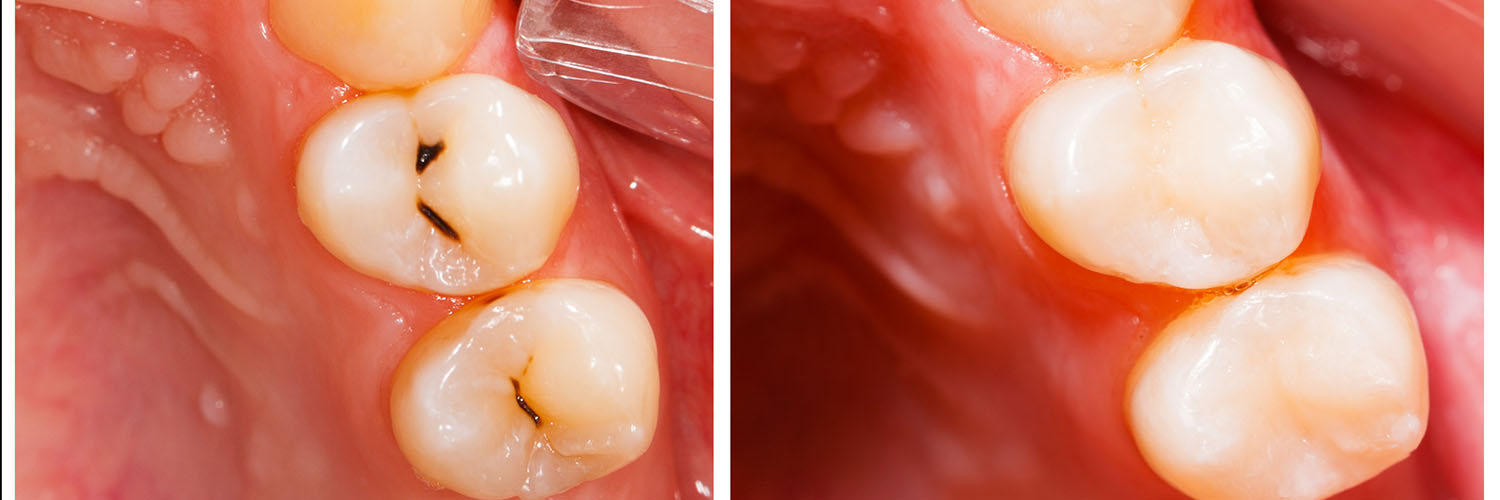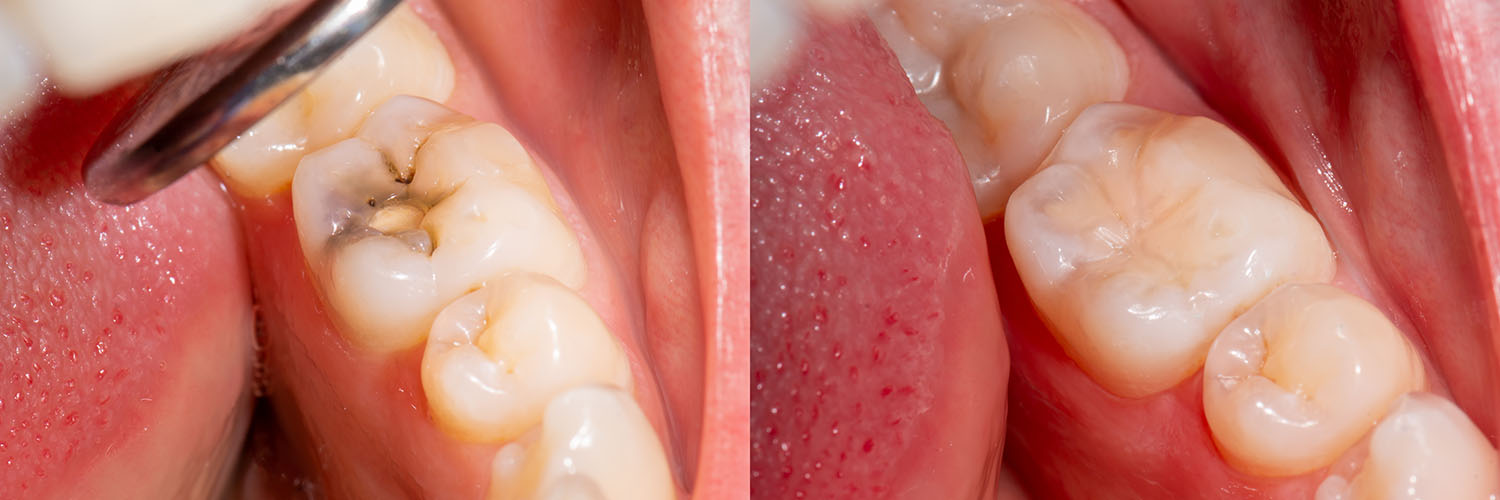
When a cavity weakens a tooth, a filling is often the simplest and most effective way to rebuild its shape and restore everyday function. Contemporary fillings do more than patch a hole — they seal the tooth against future bacterial invasion while preserving as much healthy structure as possible.
Advances in dental materials and adhesive techniques mean restorations can be both strong and discreet. Today’s options allow clinicians to match color, contour, and wear characteristics to your natural teeth, so a restored tooth can look and perform like the original.
At Addison Dental Studio, our goal is to combine clinical precision with patient comfort. We focus on conservative treatment that addresses the decay, protects the tooth, and helps you maintain a healthy smile for years to come.
Humanity has attempted to treat tooth damage for millennia, and early archaeological finds show primitive repairs dating back thousands of years. Over time, restorations progressed from rudimentary materials to the metals and ceramics used in modern dentistry.
The 19th and 20th centuries saw widespread use of metal-based fillings for their durability, but the last several decades have emphasized materials that deliver both longevity and improved aesthetics. This shift has made it easier to restore teeth without obvious cosmetic compromise.
We prioritize minimally invasive care that targets disease while preserving tooth structure. Treatment plans begin with a careful evaluation and a discussion of material choices suited to the location and function of the tooth, as well as the patient’s preferences.
Comfort and communication are central. We explain each step, use modern techniques to keep procedures efficient, and take time to confirm your bite and comfort before you leave the operatory.

Choosing the right filling material depends on where the tooth sits, how much tooth structure remains, and the functional stresses that tooth will experience. Materials vary in strength, appearance, and how they bond to the tooth.
Some options are placed directly into the prepared cavity, while others are crafted outside the mouth and bonded in later. Each approach has trade-offs between convenience, durability, and aesthetics — a clinician’s job is to match the material to the clinical situation.
Understanding the strengths and limitations of each material can help you make an informed choice in partnership with your dental provider.
Composite fillings are made from a resin matrix reinforced with glass or ceramic particles. They’re selected primarily for front teeth or visible areas because they can be closely shaded to match surrounding enamel.
Beyond aesthetics, composites bond to the tooth surface, which can add structural support and limit the amount of healthy tooth removed during preparation. Over time they can experience wear and surface staining, but with routine care they provide a reliable cosmetic solution.
Amalgam has a long history of use because it withstands heavy chewing forces and is highly durable. It’s often chosen for posterior teeth where strength is a priority and appearance is less critical.
Glass ionomers bond chemically to tooth structure and release fluoride, which can help protect the repaired area from further decay. They are frequently used in pediatric dentistry, for fillings near the gumline, or as a temporizing material.
Although convenient and protective, glass ionomers are generally less wear-resistant than composite or ceramic materials and are used selectively based on the tooth’s needs.
Ceramic restorations are fabricated in a lab or milling unit and then bonded into place. They offer excellent wear resistance and superior color stability, making them a great choice for large restorations on visible teeth.
Because they are made outside the mouth, ceramic inlays and onlays require precise impressions or digital scans and a second appointment for placement, but they can extend the life of a compromised tooth when a direct filling would not be sufficient.
Gold restorations are durable and gentle on opposing teeth; however, they are less commonly used today due to cost and cosmetic considerations. When longevity and biomechanical compatibility are paramount, metal alloys remain an excellent option.

Initial assessment starts with a clinical exam and may include radiographs or digital scans to determine the extent of decay. Once the need for a filling is confirmed, your clinician will outline a treatment plan that balances longevity, aesthetics, and conservation of tooth structure.
On the day of treatment, local anesthesia is commonly used to ensure the tooth is numb and the patient is comfortable. Modern anesthetic techniques and careful application help minimize discomfort during the procedure.
Decay is removed with precision instruments — a rotary handpiece, air abrasion, or laser in selected cases — until only healthy tooth remains. The cavity is then shaped to retain the chosen restoration, and the filling material is placed using techniques specific to that material, whether bonding and layering composites or seating a laboratory-made inlay.
For anxious patients, there are options to help manage stress during treatment; your clinician can discuss appropriate measures in advance so you feel prepared and at ease.
Following placement, it’s normal for a tooth to feel slightly different as you adapt to the new surface. Any numbness from local anesthesia typically fades within an hour or two; until it does, take care to avoid biting your lips, cheeks, or tongue.
Sensitivity for a few days after treatment — especially to temperature changes — is common and usually settles on its own. If sensitivity persists or increases, contact your dental provider for an assessment so adjustments can be made if necessary.
Good oral hygiene, routine dental checkups, and avoiding habits that place excessive stress on restorations (chewing very hard objects, for example) will help your filling perform well for many years. In some situations, a filling may eventually need repair or replacement if the tooth sustains additional decay or wear.
Not every damaged tooth is a straightforward filling case. Large areas of decay, fractures that weaken the tooth, or decay that reaches deep into the dentin may call for more extensive restorations, such as an onlay, crown, or root canal therapy followed by a crown.
Choosing the correct escalation of care protects the tooth from future breakdown and reduces the chance of repeated interventions. Your dentist will explain the reasons for recommending a more involved restoration and what that process entails.
When conservative treatment is appropriate, a well-placed filling can be a durable, esthetic solution. When a tooth requires more protection, planning a restorative solution that restores form, strength, and function becomes the priority.
In summary, dental fillings remain a cornerstone of restorative dentistry: they stop decay, restore tooth form, and preserve oral health. If you’d like to learn more about the types of fillings available or whether a filling is the best option for your tooth, please contact us for more information.
If the pleasure of eating a delicious bowl of ice cream or sipping a soothing cup of tea gets overshadowed by dental pain that makes you wince; it's time to contact our office. As skilled providers of care, we'll determine what's causing your discomfort and perform the treatment required to alleviate your symptoms and get you back on the road to oral health.
Cavities develop because of an infectious process that causes progressive damage to tooth structure. Despite starting as a pinpoint defect on the outermost enamel layer of your tooth, untreated dental decay progressively compromises more and more healthy tooth structure as it works its way to the inner layers of your tooth.
Yes, you can still develop tooth decay on other surfaces of the tooth, around the margins of an old filling, or in fewer instances, recurrent decay underneath it. For this reason, it's essential to maintain excellent oral hygiene, a diet low in sugary beverages and sweets, and be sure to visit our office for routine checkups and care. While tooth decay is second only to the common cold in frequency, it's almost entirely preventable.
We value the time and comfort of our patients. If cavities are located on adjacent teeth, or in the same section of your smile, it may be possible to treat more than one tooth during your visit. However, how much is done each visit depends on several factors. We keep our patients well informed and tailor every treatment plan and visit to address their unique needs.
Addressing concerns on the presence of elemental mercury in silver fillings, the American Dental Association (ADA), The Center for Disease Control and Prevention (CDC), the FDA, and the World Health Organization have all stated that amalgam restorations do not pose a risk to health. However, individuals with allergies or sensitivities to the metals in dental amalgam are advised to pursue other restorative options.
Dental fillings are performed under local anesthesia to help ensure your comfort throughout the entire procedure. The involved tooth remains completely numb for the extent of your visit. Within one or two hours after the procedure is completed, the local anesthetic will gradually wear off, and normal sensations return.
A tooth-colored composite filling is fully hardened and set by the end of your visit. However, we may advise you to wait a couple of hours until the local anesthesia has completely worn off. This advice is to help ensure you don't accidentally bite your lip, cheek, or tongue while still numb.
The lifetime of a dental filling varies depending on the type of material used. While popular dental materials can last a decade or more with proper care, they can degrade over time, wear down, or even break. When this happens, you may experience some tooth sensitivity, a jagged edge, or a loose or dislodged piece of filling material. Whatever the case may be, it's essential to get the filling replaced before the tooth sustains further damage or other consequences arise. Beyond taking good care of your smile to help ensure the longevity of your fillings, our office regularly checks the status of your existing fillings as part of a routine checkup exam.
Dental fillings are an essential investment that serves to preserve and protect the health of your smile. With that said, how much a filling costs depends on the number of surfaces of the tooth involved and the filling material that is used. Amalgam restorations are the most economical. While tooth-colored composite fillings have a slightly higher cost, they offer the added benefits of being metal-free and much more aesthetically pleasing. Ceramic fillings, inlays, and onlays are more expensive than the preceding options but provide outstanding, long-lasting, and natural-looking results.
Dental insurances typically cover the cost of dental fillings. While we work with you to maximize your insurance benefits, there may still be an out-of-pocket expense. At the office of Addison Dental Studio, we strive to help you begin care without any additional financial stress or delay.
Dental fillings are restorative materials used to repair teeth damaged by decay or minor fractures. They restore the tooth's shape, function and ability to resist further decay. By replacing lost structure, fillings help maintain proper chewing and prevent the need for more extensive treatment.
Modern fillings not only fill cavities but also seal margins and bond to remaining tooth structure to preserve strength. Materials and techniques have advanced so restorations can match natural tooth color and withstand routine chewing forces. At Addison Dental Studio we prioritize conservative restorations that protect teeth while maintaining a natural appearance.
The choice of filling material depends on the tooth's location, the size of the cavity and the functional stresses the tooth endures. Front teeth and visible areas often require tooth-colored materials, while back teeth may need options with higher wear resistance. Your dentist will also consider how much healthy tooth remains and any sensitivities or allergies.
Clinical factors are balanced with patient preferences for appearance and longevity when recommending a material. Digital imaging and intraoral assessment help determine whether a direct filling, an inlay/onlay or a more protective restoration is appropriate. Open communication ensures you understand the trade-offs and expected lifespan of each choice.
Composite resin is a tooth-colored material made of a plastic matrix reinforced with glass or ceramic fillers. It is placed directly into the prepared cavity and cured with a light, allowing the dentist to sculpt anatomy that blends with neighboring teeth. Because it bonds to enamel and dentin, composite often requires removing less healthy tooth structure than some traditional options.
Composites are well suited for small to moderate restorations in both front and back teeth when appearance matters. They can stain over time and may wear sooner than ceramic restorations under heavy bite forces, so careful case selection is important. Routine maintenance and good oral hygiene help extend the life of composite fillings.
Dental amalgam is a metal alloy valued for its strength and ability to withstand heavy chewing forces. It has been used for many years in posterior teeth where durability is a primary concern and esthetics are less critical. Amalgam fillings can last a long time when placed properly and monitored regularly.
Concerns about mercury content have led to extensive study; major dental organizations consider amalgam a safe and effective restorative option for many patients. For patients who prefer nonmetallic restorations there are alternative materials available that provide improved aesthetics. Your dentist can discuss the relative benefits and any clinical reasons to choose one material over another.
Glass ionomer cement bonds chemically to tooth structure and releases fluoride, which can help protect adjacent enamel from further decay. Its chemical bond makes it useful in situations where achieving a strong adhesive layer is challenging. Because glass ionomer is gentle on the tooth and easy to place, it is often used in pediatric dentistry and for lesions near the gumline.
Glass ionomers are generally less wear-resistant and less polishable than composite or ceramic materials, so they are selected based on function and longevity needs. They are commonly used as a base or liner beneath composite fillings or as a provisional restoration until a more durable solution can be placed. Your dentist will recommend glass ionomer when its protective properties and ease of use best serve the tooth's condition.
Ceramic inlays and onlays are indirect restorations fabricated outside the mouth using precise impressions or digital scans. They are bonded into place and offer excellent color stability and wear resistance compared with direct materials. Because they cover larger portions of the tooth, inlays and onlays can strengthen compromised teeth while preserving more healthy structure than a full crown.
Treatment usually requires two appointments: one to prepare the tooth and capture the impression and another to bond the finished restoration. Although this workflow takes slightly longer than a direct filling, the fit and longevity of a well-made ceramic restoration can be superior for large defects. Your dentist will advise when an onlay or inlay is the most conservative and durable option for restoring a tooth.
Cavities are diagnosed through a combination of visual inspection, tactile examination and radiographs or digital imaging to assess the depth of decay. Early lesions may be monitored or treated conservatively, while established decay generally requires restoration to prevent progression. A comprehensive assessment also evaluates the tooth's occlusion and any signs of cracks or existing restorations that affect treatment planning.
On the day of treatment local anesthesia is used as needed to ensure comfort, and the decay is removed with precision instruments or air abrasion. The cavity is shaped to retain the chosen material and, for bonded restorations, conditioned and layered to achieve a sealed bond. Final adjustments to the restoration's shape and your bite are made before polishing so the tooth feels natural and functional.
Most patients experience minimal discomfort because modern local anesthetics and delivery techniques numb the area effectively during treatment. Topical gels, careful injection techniques and short appointment times help reduce anxiety and physical discomfort for many people. If you have dental anxiety, telling your dentist allows them to tailor care to keep you relaxed throughout the procedure.
For patients with higher anxiety or complex needs, the practice can discuss adjunctive measures such as nitrous oxide or oral sedation to enhance comfort. These options are evaluated on a case-by-case basis to ensure safe and appropriate use for each patient. Clear communication about your concerns and medical history helps the team choose the most suitable approach for your care at Addison Dental Studio.
After a filling it is normal to notice slight sensitivity to temperature or pressure for a few days as the tooth adjusts to the restoration. Over-the-counter analgesics and avoiding very hot or cold foods typically help during this short period. If sensitivity worsens or persists beyond a couple of weeks, contact your dental provider for an evaluation.
Long-term success depends on good oral hygiene, regular dental exams and avoiding habits that place excessive force on restorations, such as chewing ice or opening packages with your teeth. Routine checkups allow the dentist to monitor fillings for wear, marginal breakdown or new decay so interventions can be timely and conservative. With appropriate care, many modern fillings last for years, and early detection of problems preserves tooth structure.
A filling may not be appropriate when decay is extensive, a tooth has a large fracture or the remaining structure cannot support a direct restoration. In such cases, a dentist will recommend more protective options that restore strength and prevent future failure. Decisions consider the tooth's long-term prognosis, the functional demands and patient preferences.
Common alternatives include onlays or crowns to cover and protect larger defects, and root canal therapy followed by a crown when decay reaches the pulp. Implant-supported restorations or fixed bridges may be discussed when a tooth cannot be saved and replacement is necessary to maintain function. Your dentist will explain the rationale for each option and help you choose a plan that preserves oral health while restoring comfort and function.
Quick Links
Contact Us